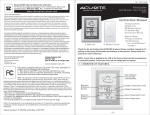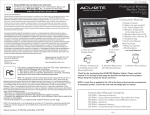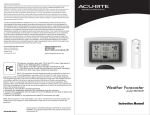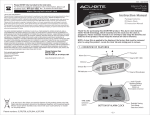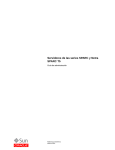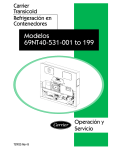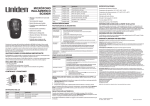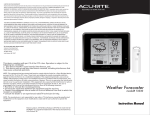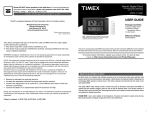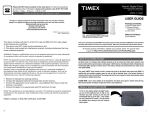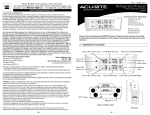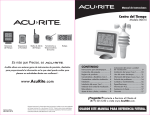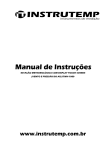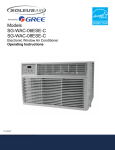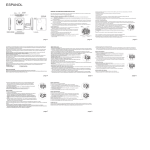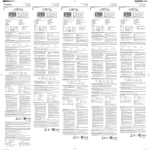Download Instruction Manual
Transcript
INST - 02002 052708 Please DO NOT return product to the retail store. For technical assistance and product return information, please call Customer Care: 877-221-1252 Mon. - Fri. 8:00 A.M. to 4:45 P.M. (CST) Wireless Thermometer with atomic clock www.chaneyinstrument.com #02002 LIMITED ONE YEAR WARRANTY Chaney Instrument Company warrants that all products it manufactures to be of good material and workmanship and to be free of defects if properly installed and operated for a period of one year from date of purchase. REMEDY FOR BREACH OF THIS WARRANTY IS EXPRESSLY LIMITED TO REPAIR OR REPLACEMENT OF DEFECTIVE ITEMS. Any product which, under normal use and service, is proven to breach the warranty contained herein within ONE YEAR from date of sale will, upon examination by Chaney, and at its sole option, be repaired or replaced by Chaney. In all cases, transportation costs and charges for returned goods shall be paid for by the purchaser. Chaney hereby disclaims all responsibility for such transportation costs and charges. This warranty will not be breached, and Chaney will give no credit for products it manufactures which shall have received normal wear and tear, been damaged, tampered, abused, improperly installed, damaged in shipping, or repaired or altered by others than authorized representatives of Chaney. THE ABOVE-DESCRIBED WARRANTY IS EXPRESSLY IN LIEU OF ALL OTHER WARRANTIES, EXPRESS OR IMPLIED, AND ALL OTHER WARRANTIES ARE HEREBY EXPRESSLY DISCLAIMED, INCLUDING WITHOUT LIMITATION THE IMPLIED WARRANTY OF MERCHANTABILITY AND THE IMPLIED WARRANTY OF FITNESS FOR A PARTICULAR PURPOSE. CHANEY EXPRESSLY DISCLAIMS ALL LIBILITY FOR SPECIAL, CONSEQUENTIAL OR INCIDENTAL DAMAGES, WHETHER ARISING IN TORT OR BY CONTRACT FROM ANY BREACH OF THIS WARRANTY. SOME STATES DO NOT ALLOW THE EXCLUSION OR LIMITATION OF INCIDENTAL OR CONSEQUENTIAL DAMAGES, SO THE ABOVE LIMITATION OR EXCLUSION MAY NOT APPLY TO YOU. CHANEY FURTHER DISCLAIMS ALL LIABILITY FROM PERSONAL INJURY RELATING TO ITS PRODUCTS TO THE EXTENT PERMITTED BY LAW. BY ACCEPTANCE OF ANY OF CHANEY’S EQUIPMENT OR PRODUCTS, THE PURCHASER ASSUMES ALL LIABILITY FOR THE CONSEQUENCES ARISING FROM THEIR USE OR MISUSE. NO PERSON, FIRM OR CORPORATION IS AUTHORIZED TO ASSUME FOR CHANEY ANY OTHER LIABILITY IN CONNECTION WITH THE SALE OF ITS PRODUCTS. FURTHERMORE, NO PERSON, FIRM OR CORPORATION IS AUTHORIZED TO MODIFY OR WAIVE THE TERMS OF THIS PARAGRAPH, AND THE PRECEDING PARAGRAPH, UNLESS DONE IN WRITING AND SIGNED BY A DULY AUTHORIZED AGENT OF CHANEY. THIS WARRANTY GIVES YOU SPECIFIC LEGAL RIGHTS, AND YOU MAY ALSO HAVE OTHER RIGHTS WHICH VARY FROM STATE TO STATE. For in-warranty repair, please contact: Customer Care Department Chaney Instrument Company 965 Wells Street Lake Geneva, WI 53147 Chaney Customer Care 877-221-1252 Mon-Fri 8:00 a.m. to 4:45 p.m. CST www.chaneyinstrument.com Instruction Manual RF WIRELESS What You Need: • Philips Screwdriver • (5) AA batteries -see “Install Batteries” A. Main Unit B. Wireless Sensor on page 2 Thank You for purchasing this ACURITE® product. Please read this manual in it’s entirety to fully enjoy the benefits and features of this product. Please keep this manual for future reference. NOTE: A clear film is applied to the LCD at the factory that must be removed prior to using this product. Locate the clear tab and simply peel to remove. 1 • OVERVIEW OF FEATURES This device complies with part 15 of the FCC rules. Operation is subject to the following two conditions: 1- This device may NOT cause harmful interference, and 2- This device must accept any interference received, including interference that may cause undesired operation. NOTE: This equipment has been tested and found to comply with the limits for a CLass B digital dvice, pursuant to Part 15 of the FCC rules. These limits are designed to provide reasonable protection against harmful interference in a residential installation. This equipment generates, uses and can radiate radio frequency energy and, if not installed and used in accordance with the instructions, may cause harmful interference to radio communications. However, There is no guarantee that interference will not occur in a particular installation. If this equipment does cause harmful interference to radio or television reception, which can be determined by turning the equipment off and on, the user is encouraged to try to correct the interference by one or more of the following measures: • Reorient or relocate the receiving antenna. • Increase the separation between the equipment and the receiver. • Connect the equipment into an outlet on a circuit different from that to which the receiver is connected. • Consult the dealer or an experienced radio/TV technician for help. Package Contents: (1) Main Unit (A) with stand (1) Wireless Sensor (B) (1) Hardware Bag (1) Instruction Manual Outdoor Temperature Wireless Sensor Signal Icon Outdoor Temperature Records Atomic Clock Atomic Clock SIgnal Icon Month & Date Indoor Temperature Setup Buttons NOTE: The manufacturer is not responsible for any radio or TV interference caused by unauthorized modifications to this equipment. Such modifications could void the user authority to operate the equipment. Tabletop Placement Display Stand Patent numbers: 5,978,738; 6,076,044; 6,597,990 -1- About the Atomic Clock A clock is considered atomic if it has an accuracy of one second in a million years. Consumer clocks are considered atomic if they attain this accuracy by receiving a signal from an atomic clock. In North America, the National Institute of Standards and Technologies operates an atomic clock in Colorado which transmits the time codes via the the radio station WWVB. The signal is transmitted in a very low frequency (60,000 Hz). The Acurite clock you have purchased includes a built-in receiver which picks up the signal from the WWVB station. For the best possible reception, place the main unit with the back side facing Colorado. NOTE: Due to solar radiation in the atmosphere, the atomic clock signal is weaker during the day. Most synchronization with the WWVB atomic clock signal happens at night when there is less interference. 40 Extended periods of cold temperatures ( below -4ºF / -20ºC ) can cause alkaline batteries to function improperly. This will cause the outdoor wireless sensor to stop transmitting temperature readings. Use lithium batteries in these low temperature conditions to ensure continued operation for wireless sensors placed outdoors. PLEASE DISPOSE OF OLD OR DEFECTIVE BATTERIES IN AN ENVIRONMENTALLY SAFE WAY AND IN ACCORDANCE WITH YOUR LOCAL LAWS AND REGULATIONS. BATTERY SAFETY: Follow the polarity (+/-) diagram in the battery compartment. Promptly remove dead batteries from the device. Dispose of used batteries properly. Only batteries of the same or equivalent type as recommended are to be used. DO NOT incinerate used batteries. DO NOT dispose of batteries in fire, as batteries may explode or leak. DO NOT mix old and new batteries or types of batteries (alkaline/standard). DO NOT use rechargeable batteries. DO NOT recharge non-rechargeable batteries. DO NOT short-circuit the supply terminals. Main Unit : Basic Setup After installing batteries, the time zone, time, DST (daylight saving time) and ºF or ºC preferences must be set initially. After the initial manual setting, the atomic clock will maintain it’s accuracy and adjust for DST automatically. 2 • SETUP Install Batteries NOTE: Install all batteries in both units within a 6 minute period to ensure proper wireless functionality. A. Wireless Sensor 1) Remove the 4 battery compartment screws. 2) Remove the battery compartment cover and install 2 fresh “AA” batteries as shown here. Always install batteries into the wireless sensor FIRST to ensure proper wireless synchronization with the main unit. B. Main Unit Remove the battery compartment cover and install 3 fresh “AA” batteries as shown here. REMOVE BATTERY COMPARTMENT COVER When first entering basic setup mode, the time zone will be flashing. Adjust the time zone using the “ ” or “ ” buttons on the side of the main unit, then press the “SET” button to confirm your time zone selection and move on. ABC Now select DST (daylight saving time) “on” or “off” by pressing the “ ” or “ ” buttons on the side of the main unit. Press the “SET” button to confirm your DST selection. Next, adjust the HOUR by pressing the “ ” or “ ” buttons on the back of the main unit. Press the “SET” button to confirm your HOUR selection and to move on to MINUTE setting. Again, adjust the MINUTE by pressing the “ ” or “ ” buttons. You may press and HOLD the “ ” or “ ” to adjust the minutes at a faster rate. Press the “SET” button again to confirm your time setting. REMOVE BATTERY COMPARTMENT COVER ABC INSTALL 3 “AA” BATTERIES Next, adjust the MONTH and then the DATE in the same manner, using the “ ” and “ ” buttons to adjust and the “SET” button to confirm and move on. Finally, press the “ ” or “ ” buttons to select between fahrenheit (ºF ) or celsius (ºC) temperature display units. Press the “SET” button one more time to exit basic setup mode. You may enter basic setup mode again at any time by pressing the “SET” button. Basic Setup is Now Complete The wireless sensor will soon send a signal to the main unit and the two units will be synchronized. It may take a few minutes for synchronization to be complete. If both or one of the units appear to be functioning improperly, refer to the troubleshooting section in this manual. -2- -3- 3 • PLACEMENT 4 • OPERATION Now that setup is complete, you must choose a location to place the wireless sensor and the main unit. The wireless sensor MUST be placed less than 100 feet away from the main unit. After the main unit and the wireless sensor are both powered on and wirelessly synchronized, no further input is required. The atomic clock will automatically re-synchronize occasionally to ensure the clock is accurate. This wireless thermometer uses radio frequency for communication, which is susceptible to interference from other electronic devices and large metallic items or thick walls. Always place both units at least 3 feet away from appliances ( TV, microwave, radios, etc. ) or objects ( large metal surfaces, thick stone walls, etc. ) that may interfere with the wireless communication. TV A 3 A Placement of Main Unit Place the main unit in a dry area free of dirt and dust. To help ensure an accurate indoor temperature measurement, be sure to place the main unit out of direct sunlight, and away from any heat sources or vents in your home. For the best possible atomic clock reception, place the main unit with the back side facing Colorado. There are 2 placement options for the the main unit. You may hang the main unit on a wall using the integrated hang holes on the bottom of the tilting display stand. Alternatively, you may place the main unit on a table top or other flat surface. RF WIRELESS A Wireless Signal Reception Icons The main unit has signal reception icons in the outdoor temperature display area and near the atomic clock display. If there are a low number of “bars” present, you may experience no temperature display ( “--” ) or inaccuracy. In either case, you may need to relocate one or both of the units. If most or all 4 of the bars are present, wireless reception is good and no action is required. If the atomic clock signal bars are low, the clock may be inaccurate or may not automatically adjust for daylight saving time (DST). Placement of Sensor The wireless sensor MUST BE PLACED OUTDOORS to observe outdoor temperatures and relay the outdoor temperature to the main unit display. The wireless sensor must be placed less than 100 feet from the main unit. The wireless sensor is water resistant and is designed for outdoor use. However, to extend the life of the product, place the wireless sensor in an area protected from direct weather elements. To ensure an accurate outdoor temperature measurement, be sure the wireless sensor is placed out of direct sunlight and away from any heat sources. -4- -5- Troubleshooting Problem Bad Temperature Reception no bars Bad Atomic Clock Reception no bars Set Wireless ID Possible Solution Relocate the main unit and/or the wireless sensor. Both units must be within 100 feet from each other. Make sure both units are placed at least 3 feet from other electronic appliances and devices that may interfere with the wireless communication (such as TV’s, microwaves, computers etc). NOTE: It may take up to 20 minutes for the main unit to resynchronize with the sensor when batteries are replaced. Relocate the main unit. Make sure the main unit is placed at least 3 feet from other electronic appliances and devices that may interfere with the wireless communication (such as TV’s, microwaves, computers etc). Large metallic surfaces will also interfere with the atomic clock signal. Make sure the back side of the main unit is facing Colorado. No Outdoor Temperature or Humidity Display (no communication) If wireless reception is bad (no bars), see “Bad Reception” section above. The wireless ID setting on each unit must match for both units to communicate properly. See “Set Wireless ID” on the next page. Main Unit Display Not Working Make certain that the batteries are installed correctly. The batteries may need replacing. This wireless thermometer uses long range 433mhz radio frequency for communication. ABC ABC In the event that you have reception problems due to interference, both the main unit and the wireless sensor have a selectable wireless ID. The ID switches are located within the battery compartments of the main unit and the wireless sensor. ABC You may choose A, B or C; but both the main units and the wireless sensors IDs must match for successful synchronization. Both wireless ID’s must match 5 • PRODUCT SPECIFICATIONS Measurement Ranges Temperature Main Unit: 32ºF to 122ºF / 0ºC to 50ºC Wireless Sensor: -40ºF to 158ºF / -40ºC to 70ºC Specifications Product Registration To receive product information, register your product online. It’s quick and easy! Log on to http://www.chaneyinstrument.com/product_reg.htm Power Requirements Main Unit: 3 x “AA” alkaline or lithium batteries Wireless Sensor: 2 x “AA” alkaline or lithium batteries Wireless Communication Radio Frequency: 433 mhz Transmission Intervals: every 16 seconds Atomic Clock Frequency: WWVB 60Khz Synchronizes Daily -6- ABC -7- INST - 02002 052708 NO regrese el producto a la tienda. Termómetro inalámbrico Para asistencia técnica e información de devolución de producto, por favor llame a Servicio al Cliente: 877-221-1252 Lun. - Vie. 8:00 A.M. to 4:45 P.M. (CST) con reloj atómico www.chaneyinstrument.com #02002 UN AÑO DE GARANTÍA LIMITADA Chaney Instrument Company garantiza que todos los productos que fabrica son de buenos material y mano de obra y están libres de defectos, si son instalados y operados adecuadamente por un período de un año desde la fecha de compra. EL RECURSO EN CASO DE INCUMPLIMIENTO DE ESTA GARANTÍA ESTÁ LIMITADO ESPECÍFICAMENTE A LA REPARACIÓN O AL REEMPLAZO DE LOS ELEMENTOS DEFECTUOSOS. Cualquier producto que, bajo el uso y servicio normal, se demuestre que incumpla con la garantía contenida en el presente documento en el plazo de un año desde la fecha de venta, será, sujeto a examen por parte de Chaney, y a su sola opción, reparado o reemplazado por Chaney. En todos los casos, los costos y cargos de transportación por productos devueltos serán pagados por el comprador. Chaney por este medio renuncia a toda responsabilidad por tales costos y cargos de transportación. Esta garantía no será incumplida, y Chaney no dará crédito por productos que fabrique los cuales hayan recibido un desgaste y deterioro normal, hayan sido dañados, manipulados, forzados, e instalados inadecuadamente, dañados en la transportación, o reparados o alterados por otros distintos que los representantes autorizados de Chaney. Manual de instrucciones RF WIRELESS LA GARANTÍA ANTES DESCRITA ES ESPECÍFICAMENTE EN LUGAR DE TODAS LAS OTRAS GARANTÍAS, EXPRESAS O IMPLÍCITAS, Y TODAS LAS OTRAS GARANTÍAS SON POR ESTE MEDIO ESPECÍFICAMENTE RENUNCIADAS, INCLUYENDO SIN LIMITACIÓN LA GARANTÍA IMPLÍCITA DE CAPACIDAD DE COMERCIALIZACIÓN Y LA GARANTÍA IMPLÍCITA DE ADECUACIÓN PARA UN PROPÓSITO EN PARTICULAR. CHANEY ESPECÍFICAMENTE RENUNCIA A TODA RESPONSABILIDAD POR DAÑOS CONSECUENCIALES ESPECIALES O INCIDENTALES, SEA QUE DERIVEN DE PERJUICIO O POR CONTRATO O DE ALGUNA INFRACCIÓN DE ESTA GARANTÍA. ALGUNOS ESTADOS NO PERMITEN LA EXCLUSIÓN O LIMITACIÓN DE DAÑOS INCIDENTALES O CONSECUENCIALES, POR LO TANTO LA LIMITACIÓN O EXCLUSIÓN ANTERIOR PUEDEN NO APLICAR A USTED. CHANEY RENUNCIA ADEMÁS A TODA RESPONSABILIDAD POR LESIÓN PERSONAL RELATIVA A SUS PRODUCTOS EN EL GRADO PERMITIDO POR LA LEY. AL ACEPTAR CUALQUIERA DE LOS EQUIPOS O PRODUCTOS DE CHANEY, EL COMPRADOR ASUME TODA RESPONSABILIDAD POR LAS CONSECUENCIAS QUE DERIVEN DE SU USO O MAL USO. NINGUNA PERSONA, FIRMA O COMPAÑÍA ESTÁ AUTORIZADA A ASUMIR POR CHANEY ALGUNA OTRA RESPONSABILIDAD EN RELACIÓN CON LA VENTA DE SUS PRODUCTOS. ADICIONALMENTE, NINGUNA PERSONA FIRMA O COMPAÑÍA ESTÁ AUTORIZADA A MODIFICAR O RENUNCIAR LOS TÉRMINOS DE ESTE PÁRRAFO, Y EL PÁRRAFO ANTERIOR, A MENOS QUE ESTO SEA HECHO POR ESCRITO Y FIRMADO POR UN AGENTE DEBIDAMENTE AUTORIZADO DE CHANEY. ESTA GARANTÍA LE DA DERECHOS LEGALES ESPECÍFICOS, Y USTED PUEDE TENER TAMBIÉN OTROS DERECHOS QUE PUEDEN VARIAR DE ESTADO A ESTADO. Para reparación en garantía, por favor contacte al: Departamento de Servicio al Cliente Chaney Instrument Company 965 Wells Street Lake Geneva, WI 53147 Chaney Servicio al Cliente 877-221-1252 Lun-Vie 8:00 a.m. a 4:45 p.m. CST www.chaneyinstrument.com A. Unidad principal B. Sensor inalámbrico Contenido del paquete: (1) Unidad principal (A) con soporte (1) Sensor inalámbrico (B) (1) Bolsa para accesorios (1) Manual de instrucciones Lo que usted necesita: • Desarmador Philips • (5) baterías AA -ver “Instalación de baterías” en la página 2 Gracias por la compra de este producto ACURITE®. Lea todo este manual para disfrutar completamente los beneficios y características de este producto. Por favor conserve este manual para referencia futura. NOTA: una película transparente se aplica al LCD en la fábrica, usted debe retirarla antes de usar este producto. Localice la lengüeta transparente y simplemente desprenda para removerla. 1 • VISIÓN GENERAL DE CARACTERÍSTICAS Este dispositivo cumple con la Parte 15 de las Reglas FCC. La operación está sujeta a las siguientes dos condiciones: 1 - Este dispositivo puede NO causar interferencia dañina, y 2 - Este dispositivo debe aceptar cualquier interferencia recibida, incluyendo interferencia que puede ser causada por operación no deseada. NOTA: Este equipo ha sido probado y se encontró que cumple con los límites para un dispositivo digital Clase B, de conformidad con la Parte 15 de las Reglas FCC. Estos límites están diseñados para proveer protección razonable contra interferencia dañina en una instalación residencial. Este equipo genera, usa y puede radiar energía de radiofrecuencia y, si no es instalado y usado de conformidad con las instrucciones, puede causar interferencia dañina a las radiocomunicaciones. Sin embargo, no hay garantía de que la interferencia no ocurrirá en una instalación en particular. Si este equipo causa interferencia dañina a la recepción de radio o televisión, lo cual puede ser determinado apagando y encendiendo el equipo, se sugiere al usuario tratar de corregir la interferencia mediante una o más de las medidas siguientes: • Reoriente o reubique la antena receptora. • Aumente la separación entre el equipo y el receptor. • Conecte el equipo a una toma de corriente en un circuito diferente de aquél al que está conectado al receptor. • Consulte al distribuidor o a un técnico de radio/TV experimentado para ayuda. Temperatura exterior Ícono de señal de sensor inalámbrico Registros de temperatura exterior Reloj atómico Ícono de señal de reloj atómico Month & Date Indoor Temperature Botones de ajuste NOTA: el fabricante no es responsable por alguna interferencia de radio o TV causada por modificaciones no autorizadas a este equipo. Tales modificaciones podrían invalidar la autoridad del usuario para operar el equipo. Soporte para visualización para colocarse sobre una mesa Patent numbers: 5,978,738; 6,076,044; 6,597,990 -1- Acerca del reloj atómico Rango de operación de las baterías Un reloj es considerado atómico si este tiene una precisión de un segundo en un millón de años. Los relojes de consumidor son considerados atómicos si estos alcanzan esta precisión recibiendo una señal de un reloj atómico. En América del Norte, el Instituto Nacional de Tecnologías y Normas (the National Institute of Standards and Technologies, en inglés) opera un reloj atómico en Colorado, el cual transmite los códigos de tiempo vía la estación de radio WWWB. Esta señal es transmitida en una frecuencia muy baja (60,000 Hz). El reloj Acurite que usted ha comprado incluye un receptor integrado el cual toma la señal de la estación WWWB. Para la mejor recepción posible, coloque la unidad principal con el lado posterior hacia Colorado. NOTA: debido a la radiación solar en la atmósfera, la señal de reloj atómico es más débil durante el día. La mayor sincronización con la señal del reloj atómico WWWB ocurre por la noche cuando hay menos interferencia. 40 Periodos extendidos de temperaturas frías (por debajo de -4ºF / -20ºC ) pueden causar mal funcionamiento de las baterías alcalinas. Esto causará el sensor inalámbrico exterior deje de transmitir las lecturas de temperatura. Use baterías de litio en estas condiciones de temperaturas bajas para asegurar la operación continua de sensores inalámbricos colocados en el exterior. ELIMINE LAS BATERÍAS VIEJAS O DEFECTUOSAS EN UNA MANERA AMBIENTALMENTE SEGURA Y DE CONFORMIDAD CON SUS LEYES Y REGULACIONES LOCALES. SEGURIDAD DE LAS BATERÍAS: siga el diagrama de polaridad (+/-) en el compartimiento de baterías. Retire inmediatamente del dispositivo las baterías descargadas. Elimine adecuadamente las baterías usadas. Se recomienda utilizar solamente baterías del mismo tipo o equivalente. NO incinere baterías usadas. NO elimine las baterías en el fuego, ya que estas pueden explotar o tener fugas. NO mezcle baterías nuevas y viejas o tipos de baterías (alcalinas/estándar). NO use baterías recargables. NO recargue baterías no recargables. NO haga cortocircuito en las terminales de suministro. Unidad principal: Configuración básica Después de instalar las baterías, las preferencias de huso horario, hora, hora de verano (DST)) y ºF ó ºC deben establecerse inicialmente. Después de la configuración manual inicial, el reloj atómico mantendrá su precisión y se ajustará a la hora de verano automáticamente. 2 • INSTALACIÓN Instalación de las baterías NOTA: Instale todas las baterías en ambas unidades en un período de 6 minutos para RETIRE LA CUBIERTA asegurar una adecuada DEL COMPARTIMIENTO DE LAS BATERÍAS funcionalidad inalámbrica. A. Sensor inalámbrico 1) Retire los 4 tornillos del compartimiento de baterías. 2) Retire la cubierta del compartimiento de las baterías e instale 2 baterías “AA” nuevas como se muestra aquí. Instale siempre las baterías en el sensor inalámbrico PRIMERO para asegurar una correcta sincronización inalámbrica con la unidad principal. B. Unidad principal Retire la cubierta del compartimiento de las baterías e instale 3 baterías “AA” nuevas como se muestra aquí. Cuando entre al modo de configuración básica por primera vez, el huso horario estará parpadeando. Ajuste el uso horario usando los botones “ ” o “ ” a un lado de la unidad principal, luego presione el botón “SET” para confirmar su selección de huso horario y continuar. ABC INSTALE 2 BATERÍAS “AA” RETIRE LA CUBIERTA DEL COMPARTIMIENTO DE LAS BATERÍAS Ahora seleccione DST (hora de verano) “on” u “off” presionando los botones “ ” o “ ” a un lado de la unidad principal. Presione el botón “SET” para confirmar su selección de hora de verano. A continuación ajuste la HORA presionando los botones “ ” o “ ” en la parte posterior de la unidad principal. Presione el botón “SET” para confirmar su selección de HORA y para continuar al ajuste de MINUTO. Nuevamente, ajuste el MINUTO presionando los botones “ ” o “ ”. Usted puede presionar y SOSTENER los botones “ ” o “ ” para ajustar los minutos a una velocidad más rápida. Presione el botón “SET” otra vez para confirmar su ajuste del tiempo. Ahora, ajuste el MES y luego la FECHA de la misma manera, usando los botones “ ” y “ ” para seleccionar y el botón “SET” para confirmar y seguir adelante. Finalmente, presione los botones “ ” o “ ” para seleccionar entre las unidades de visualización de temperatura Fahrenheit (ºF ) o Celsius (ºC) . ABC INSTALE 3 BATERÍAS “AA” Presione al botón “SET” una vez más para salir del modo de configuración básica. Usted puede entrar al modo de configuración básica nuevamente en cualquier momento presionando el botón “SET”. La configuración básica está completa ahora El sensor inalámbrico enviará pronto una señal a la unidad principal y las dos unidades estarán sincronizadas. Puede tomar unos cuantos minutos para que la sincronización termine. Si las dos o una de las unidades parecen estar funcionando en forma inapropiada, consulte la sección de solución de problemas en este manual. -2- -3- 3 • COLOCACIÓN 4 • OPERACIÓN Ahora que la configuración está terminada, usted debe elegir una ubicación para colocar el sensor inalámbrico y la unidad principal. El sensor inalámbrico DEBE ser colocado a menos de 100 pies de distancia de la unidad principal. Después de que tanto la unidad principal como el sensor inalámbrico reciban energía y estén sincronizados inalámbricamente, no se requiere ninguna otra acción. El reloj atómico se resincronizará automáticamente en forma ocasional para asegurar la precisión del mismo. Este termómetro inalámbrico usa frecuencias de radio para comunicación, la cual es susceptible a la interferencia de otros dispositivos electrónicos y de elementos metálicos grandes o de paredes gruesas. Coloque siempre ambas unidades al menos a 3 pies de distancia de los aparatos (TV, horno de microondas, radios, etc.) o de los objetos (superficies de metal grandes, paredes gruesas de piedra, etc.) que puedan interferir con la comunicación inalámbrica. TV A 3 A 100 pies máximo Colocación de la unidad principal Coloque la unidad principal en un área seca y libre de polvo. Para ayudar a asegurar una medición de temperatura interior precisa, asegúrese de colocar la unidad principal fuera del alcance de la luz directa del sol, y lejos de cualquier fuente de calor o ventilación en su hogar. Para la mejor recepción posible del reloj atómico, coloque la unidad principal con la parte posterior hacia Colorado. Hay dos opciones de colocación para la unidad principal. Usted puede colgar la unidad principal sobre una pared usando los orificios para colgar integrados en la parte inferior del soporte para visualización con inclinación. Alternativamente, puede colocar la unidad principal sobre una mesa o sobre otra superficie plana. RF WIRELESS A Iconos de recepción de señal inalámbrica La unidad principal tiene íconos de recepción de señal en el área de visualización de temperatura exterior y cerca de la pantalla del reloj atómico. Si hubiera un número bajo de “barras” presente, puede ser que no haya visualización de la temperatura ( “--” ) o que haya imprecisión. En cualquier caso, puede ser necesario reubicar una o ambas unidades. Si la mayoría o todas las 4 barras están presentes, la recepción inalámbrica es buena y no se requiere acción alguna. Si las barras de señal de reloj atómico están bajas, el reloj puede ser impreciso o puede ser que no ajuste automáticamente la hora de verano (DST). Colocación del Sensor El sensor inalámbrico DEBE SER COLOCADO EN EL EXTERIOR para observar las temperaturas exteriores y transmitir la temperatura exterior a la pantalla de la unidad principal. El sensor inalámbrico debe ser colocado a menos de 100 pies de la unidad principal. El sensor inalámbrico es resistente al agua y está diseñado para uso en el exterior. Sin embargo, para prolongar la vida del producto, coloque el sensor inalámbrico en un área protegida del efecto directo de los elementos del clima. Para asegurar una medición de temperatura exterior precisa, asegúrese de que el sensor inalámbrico sea colocado fuera del alcance directo de la luz del sol y lejos de cualquier fuente de calor. -4- -5- Solución de problemas Problema Mala recepción de temperatura (sin barras) Mala recepción del reloj atómico (sin barras) Configuración de Identificador inalámbrico Posible solución Reubique la unidad principal y yo el sensor inalámbrico. Ambas unidades deben estar a una distancia de 100 pies una de la otra. Asegúrese de que ambas unidades estén colocadas al menos a 3 pies de otros aparatos y dispositivos electrónicos que pueden interferir con la comunicación inalámbrica (tales como receptores de TV, hornos de microondas, computadoras, etcétera). NOTA: cuando se reemplazan las baterías se puede tomar hasta 20 minutos para que la unidad principal se vuelva a sincronizar con el sensor. Reubique la unidad principal. Asegúrese de que la unidad principal esté colocada al menos a 3 pies de los otros aparatos y dispositivos electrónicos (tales como receptores de TV, hornos de microondas, computadoras, etcétera). Las superficies metálicas grandes también interferirán con la señal del reloj atómico. Asegúrese de que el lado posterior de la unidad principal esté orientado hacia Colorado. No se visualiza la temperatura exterior o la humedad (sin comunicación) Si la recepción inalámbrica es mala (sin barras), vea la sección “Mala Recepción” anterior.. La configuración de Identificador inalámbrico en cada unidad debe coincidir para ambas unidades a fin de que se comuniquen adecuadamente. Vea “Configuración de Identificador inalámbrico” en la siguiente página. Unidad principal No hay visualización Asegúrese de que las baterías estén correctamente instaladas. Puede ser que se necesite reemplazar las baterías. Registro de producto Para recibir información de producto, registre su producto en línea. Es fácil y rápido! Visite http://www.chaneyinstrument.com/product_reg.htm Este termómetro inalámbrico usa frecuencia de radio de 433 mhz de largo alcance para comunicación. ABC En el caso de que usted tenga problemas de recepción debido a interferencia, tanto la unidad principal como el sensor inalámbrico tienen un identificador inalámbrico seleccionable. Los conmutadores de identificador están ubicados dentro de los compartimientos de baterías de la unidad principal y del sensor inalámbrico. Usted puede elegir A, B o C; pero tanto los identificadores de las unidades principales como de los sensores inalámbricos deben coincidir para una sincronización exitosa. ABC ABC Ambos identificadores inalámbricos deben coincidir 5 • ESPECIFICACIONES DE PRODUCTO Rangos de medición Temperatura Unidad principal: 32ºF a 122ºF / 0ºC a 50ºC Sensor inalámbrico: -40ºF a 158ºF / -40ºC a 70ºC Especificaciones Requerimientos de energía Unidad principal: 3 baterías “AA” alcalinas o de litio Sensor inalámbrico: 2 baterías “AA” alcalinas o de litio Comunicación inalámbrica Frecuencia de radio: 433 mhz Intervalos de transmisión: cada 16 segundos Reloj atómico Frecuencia: WWVB 60 Khz Sincroniza diariamente -6- ABC -7-









